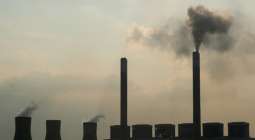Humans already have the tools to combat climate change but we lack leadership.

In this extract, top atmospheric scientist Dave Lowe explains why despite political inaction he believes we can build a sustainable future.
When it comes to the political will and leadership needed to drive the world towards a sustainable future, I’m a pessimist. Time and time again, I’ve heard rhetoric from politicians focusing on short-term goals at the expense of planning for the future. In 2021, the mainstream media promote responsible journalism and take a hard line with climate deniers. Many journalists hold governments to account over climate change goals. However, hard scientific data is often still manipulated and cherrypicked by politicians. I’ve spoken to many and liken the experience to walking through treacle.
Does their bland decision-making have to do with the structure of democracy itself, with its short electoral terms and lack of incentives for incumbent politicians to make hard and binding decisions for the decades ahead?
As I look around and see New Zealand’s highways, jammed with huge diesel trucks and ever-increasing numbers of petrol-powered SUVs and cars, I feel dread. It doesn’t have to be this way. What is it about living on a finite planet that humans either don’t or won’t understand, after all the studies and warnings show that continuing in this way leads to the inevitable collapse of the planet’s ecosystems?
When you look at the true cost of the damage to the atmosphere, politicians’ claims that action on carbon reduction is too expensive become bizarre. When we burn fossil fuels, we’ve never factored in the ultimate cost of the damage to the atmosphere caused by excess CO2. In many countries, if you pollute a waterway, you have to clean it up or pay a substantial fee for the damage – that cost has to be factored in to the cost of running your business. In the case of emitting CO2 into the atmosphere, you can do that for little or no upfront and immediate cost. Are we offended by people polluting waterways because it is literally in your face whereas CO2 is a transparent gas?
For most of the last few decades I have been disappointed with the lack of action on carbon emissions reductions by politicians. But on the other hand, I’m very optimistic when it comes to the extraordinary ingenuity of human beings. We already have the tools to combat climate change. The last two decades have seen massive advances in renewable energy electricity generation to the point where these sources are now cheaper than equivalent coal-burning power plants, even before the cost of damage to the atmosphere is taken into account. The International Energy Agency (IEA) reported that, in 2019, almost 30% of OECD electricity was met by renewable sources including hydro, solar, wind, biomass and geothermal.
Crucial to the urgent transition towards a low carbon future will be the skills and experience of engineers. Over the years I’ve spoken to many groups of engineers, including oil and gas engineers, about climate change. You’d think that a climate scientist talking to a gas engineer would lead to an argument, but that has not been my experience.
Those same gas and other engineers who have been so maligned by the green movement have the vital skills needed in a new sustainable economy.
Their skills are transferable to an economy making widescale use of “green hydrogen”, for example. Green hydrogen, produced by electrolysis of water using excess electricity derived from wind and other renewable energy sources, is already being used in steelmaking, energy storage and transport in Germany and a number of other countries.
When I talk to people about this technology and its possibilities, they are astonished. They wonder why they have never heard of it. Hydrogen fuel cell technology has been around a long time – I remember first seeing it decades ago. Why hasn’t it been used? Several reasons come to mind, including conspiracy theories about the oil companies, but to me there is a simple answer. It’s because products made from fossil fuels appear to be so much cheaper than sustainable alternatives; the true cost of the climate emergency is never factored in when the products are sold to customers.
So what is the true cost of the damage to the atmosphere when you emit a couple of tonnes of CO2 into it, perhaps during a longhaul flight between Auckland and London or by running a diesel-powered SUV for a year? There are a lot of different answers to that question depending on whether you ask an economist, politician, engineer or a climate scientist.
If you ask a chemist how, and how much it would cost, to remove a tonne of CO2 from the atmosphere, they would probably throw up their hands in horror, come up with a figure of NZ$1,000 per tonne and a very complex apparatus. A climate scientist would reply to the question with another, like, “How much do you think the 2020 wildfires in Australia, California, Colorado, Siberia and the Arctic cost?” And a New Zealand economist would quote the current carbon price on the New Zealand emissions trading scheme site, which in early 2021 was about NZ$37 per tonne. To me that sounds ridiculously cheap, measuring in crude economic terms the cost of the damage by carbon emissions into our only atmosphere.
We’ve been blinkered into thinking that there are no alternatives to fossil fuels for running an economy and society. But engineers and economists can point to several alternatives, and we need to adopt the ones that provide a sustainable future in this decade. A new field has emerged which has come to be known as “transition engineering”, where engineering and scientific principles are used to provide systems which do not compromise the ecological, societal and economic systems that future generations will depend on.
Engineering solutions will be especially valuable in tackling the rapidly growing emissions from transport. Worldwide, liquid fuels like petrol and diesel for cars and trucks, jet fuel for aviation and bunker fuels for shipping accounted for more than 20% of total CO2 emissions in 2016. Growing at a faster rate than any other sector, transport poses a major challenge to reducing emissions in line with the Paris Agreement. To keep global temperature rise within a range that averts the worst climate impacts, IPCC and other climate modelling show transport emissions must decline. Transitioning to zero-emission transport is crucial. Solutions include clean fuels, improved vehicle efficiency, changes to how we move people and goods, and building sustainable cities.
Electrification eliminates tailpipe emissions of CO2 and particles that damage our lungs. It harnesses the potential to decarbonise the power grid.
There is no doubt that reducing carbon emissions to avert disastrous impacts of climate change will be a gigantic undertaking. No single solution to this problem exists. It will require concerted effort from all parts of society, above all governments, but also engineers, scientists, economists, teachers and farmers. We can feel optimistic of the rapidly emerging technologies available to help reduce carbon emissions, among them hydrogen generation and storage from surplus electricity, synthesis of sugars from CO2 and water, information and nanotechnology, bioengineering and educational science to name a few. The challenges ahead are formidable but I truly believe that, given the will and with concerted action, human beings are more than capable of building a sustainable future.
-
Dave Lowe is an atmospheric chemist and a lead author of the 2007 Nobel Prize-winning IPCC Fourth Assessment Report on climate change. This essay is an edited extract from his book The Alarmist: Fifty Years Measuring Climate Change (VUP, NZ$40)
9 May 2021
The Guardian





